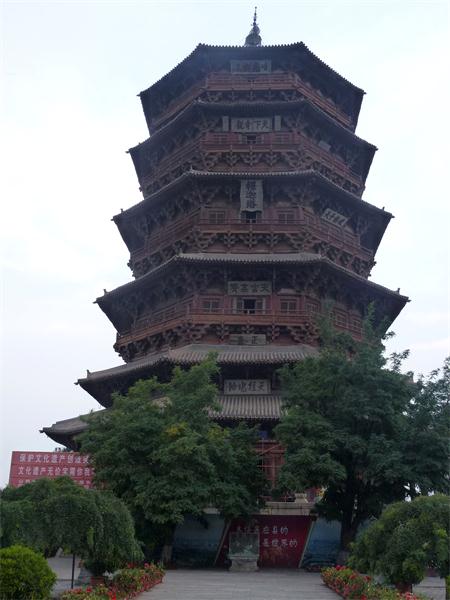The willows of Shanxi

In 19th and 20th century England, a mining and industrial economy emerged with all the horrors that it brings. Shanxi has been much the same. Yet, a country eventually responds to growing pollution problems by cleaning factory emissions and closing dirty and dangerous mining operations. Shanxi is lucky to have modern technology and a better knowledge of environmental science to help. Also, as England discovered in the 20th Century, encouraging tourism can partly replace a loss of manufacturing and mining revenue. With its history and architecture, Shanxi has an enormous amount to offer tourists. Wipe away any traces of gritty dirt to see what Shanxi is becoming.
No-one in the West has heard of Taiyuan. They say, "Oh you are going to Taiwan?" This is curious because it has been a crucial city in China's historic development over thousands of years. It is the birthplace of emperors and a capital city of Shanxi. It is the only place to have had an empress who governed China ruthlessly in order to create better and stable conditions for her people, especially for women at that time.
Taiyuan is rapidly expanding South, building modern apartment blocks, shops and parks. Roads and high speed rail travel link the city with the rest of China. The very old and interesting villages that characterised an almost lost China have been destroyed or absorbed by the city. But leave the wide and busy main roads to venture down little old lanes filled with tiny shops. Eat lamb and noodles at tables set out on pavements. You will find huge iron or wooden doors that guard private family courtyards; all that remain of the original village. Walking back into the main streets you will quickly discover a modern danger to pedestrians; electric bikes and taxis! Taiyuan has introduced and encouraged these in a further effort to reduce pollution. They are silent and deadly.
Mines close. Factories are cleaned up. Electricity from gas, wind and water power replaces coal … and trees are planted ... everywhere! The Chinese have always loved trees and flowers. Their difficult lives are brightened by natural beauty. Many trees have lime-wash painted on the lower trunks to prevent insects eating leaves. Whatever the religious or historical site, there is always an ancient tree kept alive after a thousand years! Like old men, gnarled and crippled, they lean on supports with empty memories in their open chests. Such a tree is in the Confucian temple in DaiXian county. In a courtyard designed to welcome scholars there is a 700 year old tree. People place prayer ribbons in its branches, which is exactly what the ancient Britons in Britain did, thousands of years ago. They believed a god lived deep in the earth. The blackthorn tree has deep roots and fragrant white flowers, so it must be in contact with the deity! Maybe Chinese people found more luck with the spirit of Confucius?
Travelling along the highway North to DaTong, both sides are planted with a variety of willow and poplar trees. Wire fences are turned into bushes with red creepers. Clearly not old trees, they have been planted to prevent erosion that blighted Shanxi for many years. Thirty years ago, in Lincolnshire, the vegetable garden of England, the farmers removed trees and hedges to get more land and thereby more profit. Very clever, but all their soil blew away! The dust storms even closed roads with brown fog. Years ago deforestation in Shanxi began to have similar effects. The answer? Plant trees and hedges. Willows, pines, acacia, poplar and Virginia creeper turn bare land and rusty fences into something beautiful and useful. They screen the landscape beyond, making a backdrop to the golden fields of maize and the grey mountains beyond. Countless tiny villages dot the land. Valleys and gullies have been cut into the soft sandstone by water and wind to form an incredible web, decorated with young pines.
Several years ago I was impressed by seeing an American girl pushing a flower into the muzzle of a soldier's rifle. Beautiful fields of poppies grow in the fields of the Somme in France where the blood of soldiers soaked into the earth in the First World War. Just as the tree in the Confucian temple gives a focus for prayer and gratitude, and just as the willows in Shanxi protect and preserve the earth, so the wild flowers that grow out of the Great Wall at the YanMen pass create a focus for life in a place devoted to the death of enemies. White and pink daisies compete with blue petals to clutch at life in the smallest of crevices in the rock and stone. Up the hillside are clumps of small yellow flowers.
Great battles were fought around DaTong. Four famous generals belonging to one family died in battles here. The rich history of the YanMen pass, being the "First pass of China" to Inner Mongolia, is a sweet sauce to pour over this section of the Great Wall. Yet, it's all made insignificant by a small daisy!
A rare wooden pagoda in Yingxian, built in 1056, is awesome in its height and structure. Constructed with pine, it uses no nails but interlocking joints. Other pagodas long ago collapsed, but the use of wood gives this one flexibility and strength. Swallows build nests in its eaves and eat any insects found in the timber. The natural structure survives earthquakes as a monument to ancient Chinese architecture and life enduring in its arms.
In Shanxi millions of trees are grown. Some areas will remain as forest and other trees are replanted all over Shanxi in any space and along roadsides. Approaching Yungang, the closed coal mines ghost the left of the road, but are invisible behind the pines and silver birch. On hills to the right is a wind farm as a dramatic contrast to earlier coal power. In the middle of the two is the road leading to the most amazing Buddhist site; the Yungang grottoes. Under a clear blue sky, more trees border the site. Some 50,000 images and statues are carved into the sandstone, many 1000 years old. Up to 40,000 people worked to produce these over three dynasties. Contrasting with the hard cliff face and the man-made carvings are those red flowers and delicate daisies.
China will be a beautiful place when it is finished, and Shanxi is certainly creating natural beauty in a place known for its industrial and military might.




















